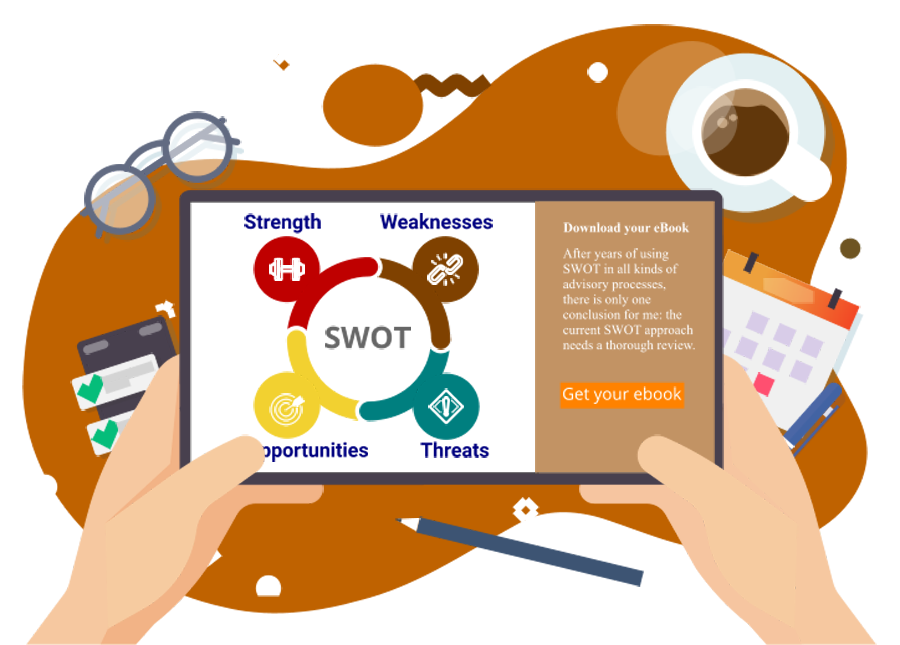The result of a SWOT session
SWOT has been around for a long time; you can’t really get around it. Organizations often see it as an obligation in a plan or description of what an organization is doing. It is used to analyze the strategy.
It supports an analysis of an organization or project. What are the strong points and where does an organization fail. In addition, the challenges and obstacles provide insight into the external position of an organization. SWOT is a strategic analysis and in fact nothing more than that. A snapshot that shows where an organization, or part of it, stands.
The SWOT analysis is an integral part of all kinds of follow-up processes. Objectives, plans, actions, improvements with which the organization can get started. Consultants are happy to support companies in developing plans to get the organization moving. All kinds of methods, tools and training courses are available for this.

In addition to an analysis, a SWOT also provides a team feeling. Even though a SWOT ends up looking for the threats. That is often an unpleasant ending. Often, however, SWOT participants do not hear back about the results of the SWOT analysis. Usually it takes a few weeks or months before you get feedback. Often there is a lack of insight into specific objectives and a concrete action plan. What happens to the results of a SWOT analysis often remains unclear. That is a disappointing feeling. The motivation, the positive feeling and the willingness to take action quickly disappear.
The dynamics of organizations
Organizations develop and change themselves over time in order to be able to successfully continue to offer products and/or services to their customers. The culture of an organization forms the basis for effective operation. It is a dynamic interplay of people who contribute to success. It’s about what people do together. It forms the basis for cohesion, dynamism and innovation. Structures, processes and desired behavior are created on the basis of the culture.
The only thing that is constant in organizations is movement. And that is exactly what the leaders of those organizations find important and necessary in a rapidly changing market.
How do you get a team of people with different competencies moving? What does it take to innovate? How do you form the basis in an organization to form a winning and enthusiastic team?
Does a SWOT analysis still fit as a tool in the setting of a dynamic organization? How annoying is it that the SWOT leads to a static analysis instead of a dynamic process?
The result of a SWOT 2.0 session
The result of the SWOT 2.0 session is much better suited to a dynamic and evolving organization. It fits in with a culture of development and innovation. Where a SWOT is a snapshot, SWOT2.0 actually takes an organization further into action.

In addition to an analysis, the end result of a SWOT, there are a number of specific characteristics that distinguish SWOT 2.0 from a SWOT analysis.
- SWOT 2.0 gives more direction by focusing and limiting in the beginning.
- SWOT 2.0 works in a process: analysis, goals, obstacles and action plan.
- SWOT 2.0 seeks opportunities without prejudice about strengths.
The obstacles that stand in the way are only identified after specific goals have been determined.
After a SWOT 2.0 session, you can start execution the next day, which is much more powerful than with a SWOT analysis.
Dynamics of SWOT 2.0
SWOT 2.0 suits organizations that envision a culture of connecting, innovating and improving. The organizations that perform a static SWOT analysis miss precisely those aspects.
- More than 80% want more than a strategic analysis.
- It is virtually impossible to arrive at an action plan through SWOT analysis.
- There is a lack of clarity among SWOT participants as to what exactly the analysis focuses on. You get a little surprising result.
- More than 90% of the SWOT sessions mainly provide a lot of generalities.
- Weaknesses and threats especially give a lot of negative energy to team members.
- More than 60% of SWOT analyzes disappear in a desk drawer, without doing anything with them.
- Combining internal and external factors and basing a kind of action plan on this is a time-consuming and laborious process.
- The SWOT is a static analysis, it does not inspire or motivate a team to turn strategy into action.
- Combining internal and external factors and basing a kind of action plan on this is a time-consuming and laborious process.
- The SWOT is a static analysis, it does not inspire or motivate a team to turn strategy into action.

Where SWOT is static and requires a follow-up, SWOT 2.0 is the immediate start of an improvement process. SWOT 2.0 sets an organization in motion and gives a team the opportunity to immediately convert enthusiasm, involvement and insight into action.
Conclusions
Unlike the end result of a SWOT, a SWOT 2.0 session delivers focused goals and a concrete plan of action. Setting goals, identifying obstacles and creating an action plan are an integral part of SWOT 2.0. And that while a SWOT 2.0 session does not take more time than a SWOT analysis. SWOT 2.0 suits an organization with a dynamic culture. An organization that sees product and market innovation and time-to-market as core values to operate successfully.




